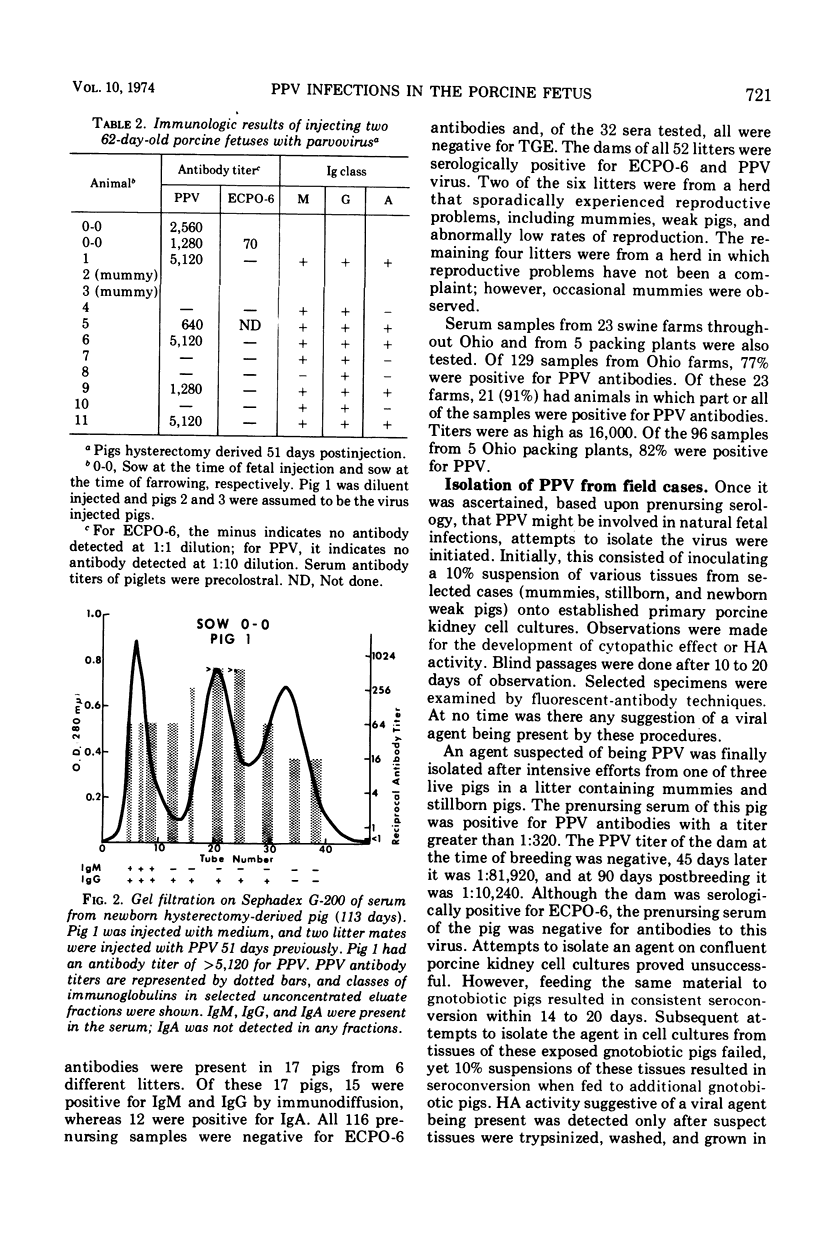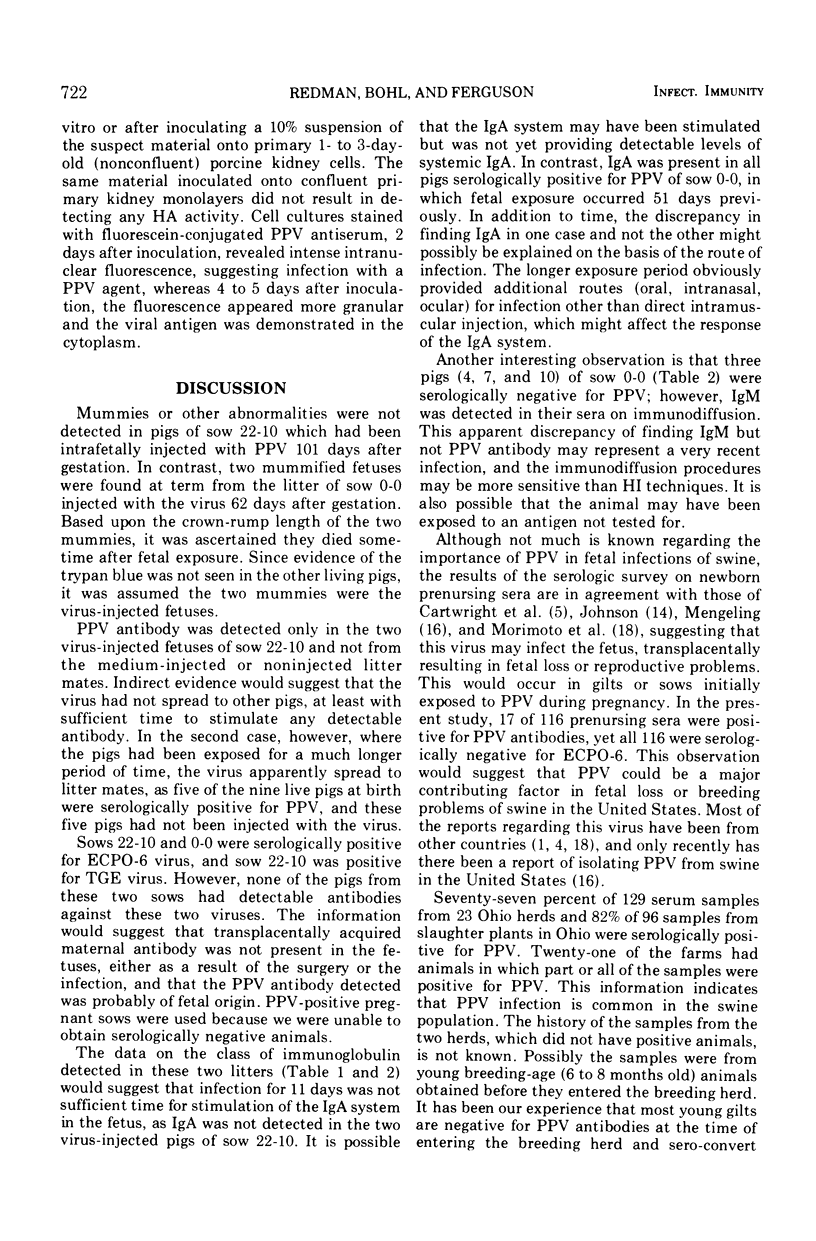Abstract
Antibodies against porcine parvovirus were detected in 17 of 116 prenursing pig sera. Antibodies against transmissible gastroenteritis or ECPO-6 (an enterovirus) were not detected in prenursing sera of the pigs tested. Seventy-seven percent of 129 serum samples from 23 Ohio farms and 82% of 96 samples from slaughter plants in Ohio were serologically positive for porcine parvovirus. Mummies or other abnormalities were not observed in newly born pigs exposed to porcine parvovirus by the transuterine route 101 days after gestation. Indirect evidence suggested that the virus had not spread to other fet uses following exposure after 101 days at least not in a sufficient amount of time to stimulate detectable antibody. Direct intrafetal exposure to porcine parvovirus (i.m. injection, transutero) after 62 days of gestation resulted in dealth and mummification of the two fetuses, and apparently in the subsequent spread of the virus, as five of nine live pigs born were serologically positive for porcine parvovirus and these five pigs had not been injected with the virus. Immunoglobulin G was detected in all newborn pigs irregardless of known antigenic stimulation or the presence of specific antibody. In general, the presence of immunoglobulin M or immunoglobulin A in fetal serum was correlated with a history of antigenic stimulation or the presence of detectable antibody.
Full text
PDF





Selected References
These references are in PubMed. This may not be the complete list of references from this article.
- Bohl E. H., Gupta R. K., Olquin M. V., Saif L. J. Antibody responses in serum, colostrum, and milk of swine after infection or vaccination with transmissible gastroenteritis virus. Infect Immun. 1972 Sep;6(3):289–301. doi: 10.1128/iai.6.3.289-301.1972. [DOI] [PMC free article] [PubMed] [Google Scholar]
- Cartwright S. F., Lucas M., Huck R. A. A small haemagglutinating porcine DNA virus. I. Isolation and properties. J Comp Pathol. 1969 Jul;79(3):371–377. doi: 10.1016/0021-9975(69)90053-x. [DOI] [PubMed] [Google Scholar]
- Cartwright S. F., Lucas M., Huck R. A. A small haemaggultinating porcine DNA virus. II. Biological and serological studies. J Comp Pathol. 1971 Jan;81(1):145–155. doi: 10.1016/0021-9975(71)90067-3. [DOI] [PubMed] [Google Scholar]
- Dunne H. W., Clark C. D. Embryonic death, fetal mummification, stillbirth, and neonatal death in pigs of gilts vaccinated with attenuated live-virus hog cholera vaccine. Am J Vet Res. 1968 Apr;29(4):787–796. [PubMed] [Google Scholar]
- Dunne H. W., Gobble J. L., Hokanson J. F., Kradel D. C., Bubash G. R. Porcine reproductive failure associated with a newly identified "SMEDI" group of picorna viruses. Am J Vet Res. 1965 Nov;26(115):1284–1297. [PubMed] [Google Scholar]
- Emerson J. L., Delez A. L. Cerebellar hypoplasia, hypomyelinogenesis, and congenital tremors of pigs, associated with prenatal hog cholera vaccination of sows. J Am Vet Med Assoc. 1965 Jul 1;147(1):47–54. [PubMed] [Google Scholar]
- HANCOCK B. B., BOHL E. H., BIRKELAND J. M. Swin kidney cell cultures-susceptibility to viruses and use in isolation of enteric viruses of swine. Am J Vet Res. 1959 Jan;20:127–132. [PubMed] [Google Scholar]
- Johnson R. H. A search for parvoviridae (picodnaviridae). Vet Rec. 1969 Jan 4;84(1):19–20. doi: 10.1136/vr.84.1.19. [DOI] [PubMed] [Google Scholar]
- Johnson R. H., Collings D. F. Experimental infection of piglets and pregnant gilts with a parvovirus. Vet Rec. 1969 Oct 18;85(16):446–447. doi: 10.1136/vr.85.16.446. [DOI] [PubMed] [Google Scholar]
- Johnson R. H., Collings D. F. Transplacental infection of piglets with a porcine parvovirus. Res Vet Sci. 1971 Nov;12(6):570–572. [PubMed] [Google Scholar]
- Mayr A., Bachmann P. A., Siegl G., Mahnel H., Sheffy B. E. Characterization of a small porcine DNA virus. Arch Gesamte Virusforsch. 1968;25(1):38–51. doi: 10.1007/BF01243088. [DOI] [PubMed] [Google Scholar]
- Mengeling W. L. Porcine parvovirus: properties and prevalence of a strain isolated in the United States. Am J Vet Res. 1972 Nov;33(11):2239–2248. [PubMed] [Google Scholar]
- Morimoto T., Fujisaki Y., Ito Y., Tanaka Y. Biological and physicochemical properties of porcine parvovirus recovered from stillborn piglets. Natl Inst Anim Health Q (Tokyo) 1972 Fall;12(3):137–144. [PubMed] [Google Scholar]
- Morimoto T., Kurogi H., Miura Y., Sugimori T., Fujisaki Y. Isolation of Japanese encephalitis virus and a hemagglutinating DNA virus from the brain of stillborn piglets. Natl Inst Anim Health Q (Tokyo) 1972 Fall;12(3):127–136. [PubMed] [Google Scholar]
- Saif L. J., Bohl E. H., Gupta R. K. Isolation of porcine immunoglobulins and determination of the immunoglobulin classes of transmissible gastroenteritis viral antibodies. Infect Immun. 1972 Oct;6(4):600–609. doi: 10.1128/iai.6.4.600-609.1972. [DOI] [PMC free article] [PubMed] [Google Scholar]
- WADSWORTH C. A slide microtechnique for the analysis of immune precipitates in gel. Int Arch Allergy Appl Immunol. 1957;10(6):355–360. doi: 10.1159/000228394. [DOI] [PubMed] [Google Scholar]


